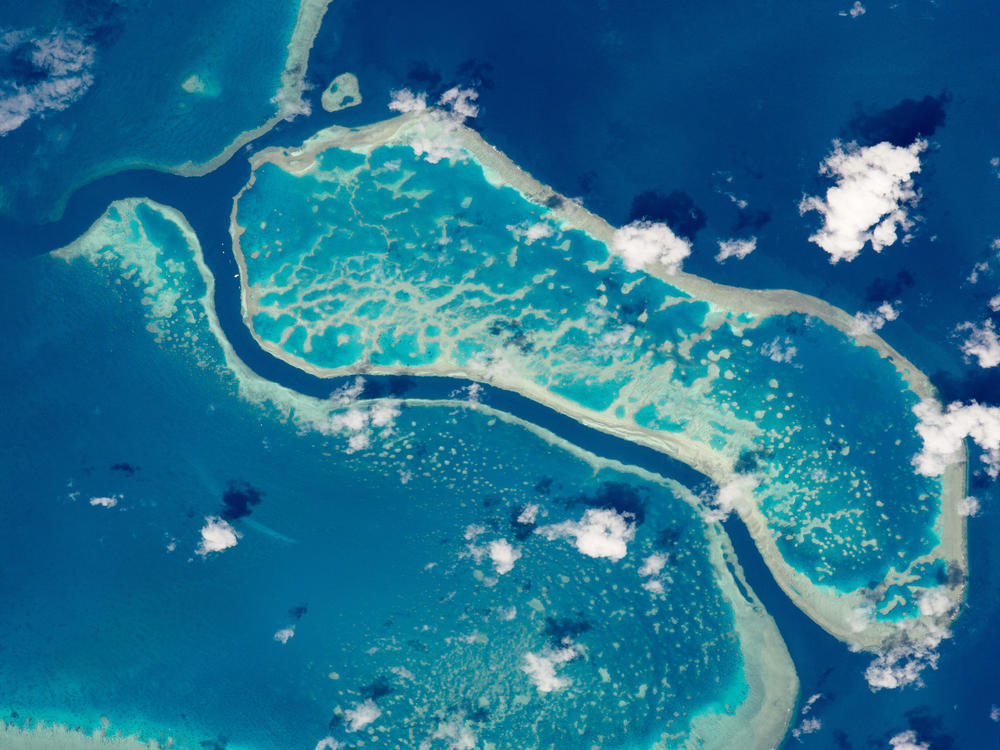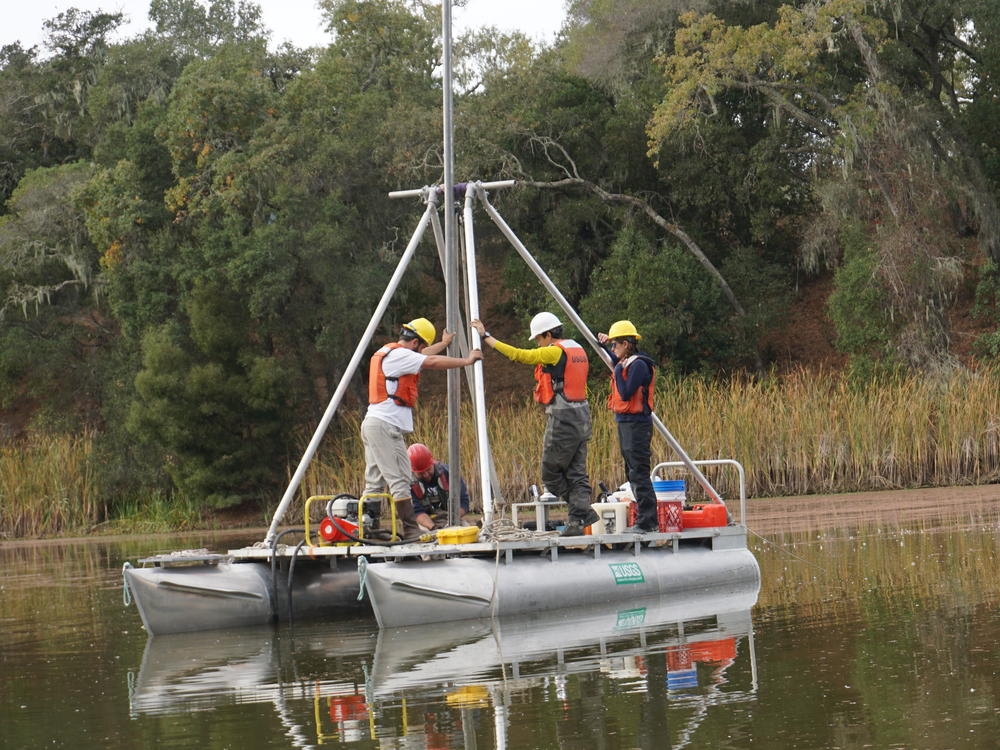Section Branding
Header Content
Drawing A Line In The Mud: Scientists Debate When 'Age Of Humans' Began
Primary Content
Humans have changed the Earth in such profound ways that scientists say we have entered a new geological period: the Anthropocene Epoch.
But when did the new epoch officially begin? And how, exactly, should it be defined?
Those are the questions that geologists are pursuing with increasing urgency at sites around the world. Teams are studying 11 locations on five continents, looking for a place where rock, mud or ice perfectly capture the global impact of humans.
As is often the case in science, the teams are both collaborating and competing. They share information, but ultimately only one site will be crowned the "golden spike" location for the Anthropocene: the place on Earth where a line in the rock, mud or ice exemplifies the unique markers of the age of humans.
Every geological period has a golden spike location that allows scientists to pinpoint when the period began by identifying a specific layer in rock, mud or ice and assigning a date to that layer.
For example, there is a line of pollen and dust in a specific ice core from Antarctica that is the official reference point for the beginning of the Holocene epoch, which commenced when the last ice age ended about 12 thousand years ago. The golden spike location for the end of the age of dinosaurs about 66 million years ago is a line in a cliff in Tunisia, where global debris from a meteor impact is clearly visible.
But finding a golden spike location for the age of humans has been tricky. "It has caused quite heated debate as to what the Anthropocene is," says Colin Waters, a geologist and the chair of the Anthropocene Working Group, which coordinates the golden spike research sites.
Anthropologists, sociologists and historians all disagree about when the age of humans began, or if such an age epoch even exists.
"There are some people who see an old Anthropocene that goes all the way back to when we see humans controlling and using fire, a hundred thousand years ago," says Nicholas Kawa, an anthropologist at Ohio State University. Others point to the dawn of agriculture as the moment that humans began to have large-scale impacts on the planet.
Still others, including prominent indigenous scholars, point to colonialism as the turning point.
"By linking the Anthropocene with colonization, it draws attention to the violence at its core and calls for the consideration of Indigenous philosophies and processes of Indigenous self-governance as a necessary political corrective," wrote scholars Zoe Todd and Heather Davis in a 2017 paper titled On the Importance of Date, or Decolonizing the Anthropocene.
But the geologists on the Anthropocene Working Group disagree with the idea that the age of humans began hundreds or even thousands of years ago. They argue that industrialization and the nuclear age are the best geological markers of the new epoch. Specifically, scientists on the golden spike teams are zeroing in on a period in the 1940s and 1950s when some humans began detonating nuclear bombs.
"There are many potential markers, but a favorite would be radionuclides from fallout," says Waters of the Anthropocene Working Group. The Manhattan Project and the bombs the U.S. dropped on Japan during World War II released plutonium and other radioactive elements into the atmosphere near where the detonations happened.
But fallout didn't truly blanket the Earth until the U.S. and Soviet Union began testing much larger bombs in the early 1950s. "It's not really until you get to about 1952 — the big thermonuclear detonations — that you start to see these radionuclides appearing everywhere," Waters says.
That's why 1952 is looking like the front-runner for the official start of the Anthropocene Epoch.
"I talk to my mom about this because I think it's really funny," says geographer and Anthropocene Working Group secretary Simon Turner. "My parents were born in a different geological epoch."
In order for 1952, or any other year, to be officially recognized, the members of the Anthropocene Working Group must vote on a golden spike location. That vote is planned for 2022, which may seem a long way away but, as Turner puts it, "it takes time to do science." The clock is ticking.
As a result, 2020 was a major year for scientists working at potential golden spike sites in Asia, Europe, North America, Australia and Antarctica. Each site was chosen because it has undisturbed layers of mud, ice or rock that have collected dust, debris, chemicals and other evidence of human activity. Some sites have been studied for decades, which means scientists have quite a bit of information about what is trapped below the surface.
In the last year, that research has gone into overdrive as scientists work to compile final arguments for why their site is a perfect example of the Anthropocene. In 2020, Polish researchers analyzed mud from a peat bog on the border between the Czech Republic and Poland. Chinese researchers took a core sample from the bottom of a lake in northeastern China and began looking for radioactive cesium as well as soot from burning fossil fuels — a likely secondary marker of the Anthropocene. Australian researchers looked for radioactive isotopes in coral, and researchers in Germany are looking for microplastics in mud from the bottom of the Baltic Sea.
The work is painstaking and each site presents different challenges. A site in Antarctica relies on a 133-meter-long ice core that was drilled in 2012. Another site in California required that scientists drill three stories down into the mud below a reservoir that was constructed in the late 1800s and quickly filled with sediment.
"At this point there's over 11 meters of sediment since 1892," says Alison Stegner, a geologist at Stanford University and the leader of the team that's investigating the reservoir as a potential golden spike location for the Anthropocene.
The sediment is bad news for the people who built the reservoir to hold water, not mud, but it's a boon for scientists. "When we have a lot of sediment in a site like this, it gives us the ability to study what happened in the past in really fine resolution," says Stegner. "We can actually look at what happened seasonally over the last 127 years which is really, really rare."
That's because each summer, plants grow and die in the reservoir, and a layer of organic matter collects on the bottom. Each winter, a large amount of sandy sediment arrives with the rainy season. Stegner and her team can count those summer-winter couplets to go back in time and estimate the exact year of every layer in the mud. If they find a layer with radioactive elements, they may be able to pinpoint not just the year, but the season. For example, winter 1952.
Stegner has been working on this project for years at this point. The finish line is looming. Her team will submit their results in the next year or so, at which point she'll get to see how the mud from her reservoir stacks up against all the other Anthropocene evidence.
"I mean, I'd be lying to say I'm not a little bit competitive," Stegner says. "But at the same time everyone else who's working on sites around the planet are our collaborators, so in many ways we're lifting each other together."
She also finds the work sobering in many ways. "It's really exciting. It's also alternately a little rattling," Stegner says. "We're thinking about changes to our planet that are so monumental we need to name a new epoch."
Kawa, the anthropologist, says officially defining the Anthropocene Epoch will create more questions than it answers for people who are grappling with how humans live on this planet. For example, what does it mean for the age of humans to be officially defined by some of humanity's most destructive acts?
"You think of so many nasty facets of human history that we like to sweep under the rug," Kawa says. "It could actually be helpful to say 'We're using an atomic bomb to define the human era. What does that say about us? And what do we want future markers to look like?' "
And, he says, the Anthropocene epoch is unique because it mixes sweeping geologic history with narrow questions of human responsibility and morality. Geologists who study the age of dinosaurs don't have to think about who was responsible for the meteor that ended it all. "Meteors, we don't think about them in ethical or moral terms," Kawa says.
The Anthropocene is the work of men — some more than others. "We have to be careful not to lay responsibility at the feet of all humans broadly," Kawa says, "because some people and some human groups and some social institutions are more responsible for it."
Copyright 2021 NPR. To see more, visit https://www.npr.org.


